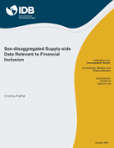Sex-disaggregated Supply-side Data Relevant to Financial Inclusion
Date
Aug 2016
At the global level, efforts to measure and monitor financial inclusion indicators have been increasing. However, there is still a substantial lack of sexdisaggregated data, particularly from the supply side; that is, data compiled from information provided by financial institutions. Among the countries of LatinAmerica and the Caribbean (LAC), there is a systematic lack of sexdisaggregated data at both the public and private sector levels. This impacts negatively on efforts to improve financial inclusion, as it hampers the design of
strategies with actions and objectives that are more appropriate for men and women and makes it impossible to evaluate public intervention or measure progress. This paper seeks to help close the supply-side data gap and proposes a set of sex-disaggregated supply-side data indicators, based on both international data-gathering initiatives and those undertaken at the national level
in LAC. It suggests that financial regulators in LAC should collect supply-side data gradually to build a database that is harmonized and comparable among the region’s countries. Such data would facilitate the study, monitoring, and comparison of progress on financial inclusion for men and women. It would also facilitate the design of appropriate policies and reforms.
strategies with actions and objectives that are more appropriate for men and women and makes it impossible to evaluate public intervention or measure progress. This paper seeks to help close the supply-side data gap and proposes a set of sex-disaggregated supply-side data indicators, based on both international data-gathering initiatives and those undertaken at the national level
in LAC. It suggests that financial regulators in LAC should collect supply-side data gradually to build a database that is harmonized and comparable among the region’s countries. Such data would facilitate the study, monitoring, and comparison of progress on financial inclusion for men and women. It would also facilitate the design of appropriate policies and reforms.




